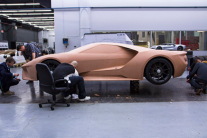Traci Birch Lecture as part of the Ed Mathes Lecture Series
Model cars: Clay-crafted autos rolling out for Design Week
Tue, 10/10/2017 - 3:16pmDesigning today’s high-tech automobiles often begins with a decidedly low-tech block of clay.
Two automotive clay modelers from the Ford Design Center – including a University of Louisiana at Lafayette graduate – will discuss and demonstrate their craft as part of Design Week activities in the School of Architecture and Design.
Lloyd VandenBrink, a master modeler and manager of the Ford Truck Studio, will explain design modeling at 1 p.m. on Friday, Oct. 20. Jason Mosery, a 2015 graduate of the Industrial Design program, will share his experiences at the Ford Design Center at 1 p.m. on Saturday, Oct. 21. Both discussions will be held in 134 Fletcher Hall on the UL Lafayette campus.
Ford will deliver about a thousand pounds of clay for the demonstrations. The automotive manufacturer will also provide models of a Mustang and F-150 truck. They are 4:10 scale, about two-fifths the size of the full-size replicas produced at the design center in Dearborn, Michigan.
The smaller models are produced when a computer-assisted design program directs a milling machine to shave a block of clay into the familiar form of an automobile.
The unfinished replicas will be completed once they arrive at UL Lafayette. They’ll be displayed alongside a 2017 Mustang and a Ford Raptor truck provided for exhibition by Hub City Ford in Lafayette. Members of the Ford and Mustang Club of Acadiana will showcase classic cars at the event, as well.
VandenBrink and Mosery first will use sculpting tools that resemble small garden rakes to smooth the clay and remove cutting marks left by the milling machine. They’ll then use a process called DI-NOC, the trade name of a stretchable film that simulates the appearance and texture of a painted surface.
“It’s a very thin vinyl. It’s squeegeed onto the clay surface and it looks just like a painted model,” said Jerry Malinowski, a professor and coordinator of UL Lafayette’s Industrial Design program.
The final step is to apply a foil to the model that replicates chrome.
The Design Week activities are a chance to see a process that usually takes place behind closed doors, Malinowski said. He witnessed it when he worked for the Ford Design Center in the early 1960s. Malinowski was part of the team that first penned the iconic Ford Mustang in 1962.
“I saw these guys make magic in clay. It’s a fascinating adventure to see this whole process,” he said.
Car manufacturers have used clay to design full-scale models of automobiles since the 1920s. They enable company executives, clients and investors to envision proposals three-dimensionally, a sense of proportion that flat diagrams or artist renderings can’t deliver.
The time-tested method has something else designers need: alterability.
VandenBrink told the BBC last year that clay is “easy to change – you just add it, or take it away. It allows you to be creative and come up with something quickly. 3-D printing, on the other hand, is just that, printing.”
Malinowski said auto companies began phasing out clay modeling in the mid-1990s in favor of digital technology. They soon realized their error.
“They found out that what you see digitally is not real. You just don’t get the realization. It’s not like seeing the actual model. There’s nothing like that physical model.”
UL Lafayette requires its industrial design students to build models of their work, which is something many university programs have eliminated in recent years. Students also learn digital design techniques, and the two skills – the time-tested and the technologically advanced – are enticing to future employers, Malinowski said.
Four of his former students are among 160 modelers employed by the Ford Design Center: Mosery; Ronnie Coniglio, who graduated in 2017; and Aaron Depino and Ian Darrow, both 2016 graduates.
“Lloyd (VandenBrink) calls them his ‘Southern contingent.’ All four of them are in one studio,” Malinowski said.
“Ford loves us. These guys are really performing for them. They were all top-notch students.”
Caption: Clay modelers sculpt the Ford GT last year at the company’s design center in Dearborn, Michigan. The GT is a mid-engine two-seater sports car. (Credit: Photo courtesy of Ford)

